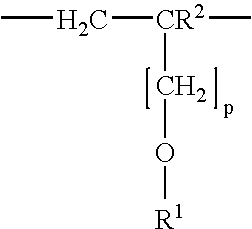Gypsum products utilizing a two-repeating unit dispersant and a method for making them
a technology of gypsum and dispersant, which is applied in the field of fast drying gypsum products, can solve the problems of occupying a large space to stack and store wallboard, affecting the quality of gypsum products, and requiring a large amount of space to move and move, so as to reduce the amount of time or the temperature of the oven, reduce the cost of fuel burden of ovens, and save costs
- Summary
- Abstract
- Description
- Claims
- Application Information
AI Technical Summary
Benefits of technology
Problems solved by technology
Method used
Image
Examples
example 1
[0054] Tests were conducted to determine the effect of the addition of potassium carbonate on two different dispersants. In each of the following samples, a gypsum slurry was made from 400 grams of stucco from Southard, Okla., 180 grams of water and 0.2% dispersant based on the dry weight of the stucco. The 211 dispersant was made according to Preparation Example 3 of U.S. Ser. No. 11 / 152,678, filed Jun. 14, 2005, and U.S. Serial No. 11 / xxx,xxx (Attorney Ref. DCP 3), both entitled “Polyether-Containing Copolymer” and hereby incorporated by reference. The dispersant type and amount of potassium carbonate are shown in Table I below, together with the results of the patty size and the stiffening rate tests.
TABLE IPotassiumPatty Size,StiffeningDispersantCarbonate, gcmTime2110.630.36:002110.019.82:05MELFLUX 2500L0.626.010:30 MELFLUX 2500L0.015.52:35
[0055] As is seen in the data in Table I above, the two-repeating unit dispersant of this invention, 211, shows reduced stiffening time bot...
example 2
[0056] The preferred 211 dispersant was tested with a variety of modifiers to determine the improvement in efficacy. Reagent grade tetra sodium phosphate (TSP), tetra sodium pyrophosphate (TSPP) and sodium carbonate (Soda Ash) were tested. DEQUEST 2006, a penta sodium salt of aminotri (methylene phosphonic acid), available from Solutia Inc., St. Louis, Mo., was also tested.
[0057] For all testing samples, the water to stucco ratio was 0.5 and 0.66% by weight wet gypsum accelerator (WGA) based on the dry weight of the stucco was added. The control sample had only 0.5% by weight WGA. The amount of each modifier added is shown in Table II, along with the set time and patty size produced by each sample.
[0058] The modifier and dispersant were added to the water, followed by addition of the stucco and WGA. The slurry was stirred until it was consistent.
TABLE IIDEQUESTSodaModifierControl2006TSPTSPPAshAmount00.05%0.05%0.05%0.15%Patty Size20 cm23.7 cm21.5 cm25.5 cm27.5 cmStiffening2:152:3...
example 3
[0060] Plant trials were conducted to test the ability of the dispersant to reduce water in wallboard made on a production line. Stucco was delivered to a high shear mixer via a conveyor. Dry additives, such as the starch, were added to the conveyor as the stucco was transported. Gauge water was added to the mixer in an amount necessary to produce the target water to stucco ratio after water in the liquid additives was considered. Trimetaphosphate was added by a separate line directly to the mixer. All components were blended in the mixer until a homogeneous slurry was obtained. The base composition of the slurry is provided in Table III.
TABLE IIIBase Composition, lbs. per 1000 ft2 (308 m2)Stucco 1714 lbs. (779 kg)Wet Gypsum Accelerator 45 lbs. (20.5 kg)Soap 0.42 lbs. (19 g)
[0061] The dispersant was blended to the gauge water prior to its introduction into the mixer at the dosages shown in Table III. The dosage shown is based on the weight of the dry dispersant as a percentage of...
PUM
| Property | Measurement | Unit |
|---|---|---|
| weight ratio | aaaaa | aaaaa |
| weight ratio | aaaaa | aaaaa |
| molecular weight | aaaaa | aaaaa |
Abstract
Description
Claims
Application Information
 Login to View More
Login to View More - R&D
- Intellectual Property
- Life Sciences
- Materials
- Tech Scout
- Unparalleled Data Quality
- Higher Quality Content
- 60% Fewer Hallucinations
Browse by: Latest US Patents, China's latest patents, Technical Efficacy Thesaurus, Application Domain, Technology Topic, Popular Technical Reports.
© 2025 PatSnap. All rights reserved.Legal|Privacy policy|Modern Slavery Act Transparency Statement|Sitemap|About US| Contact US: help@patsnap.com



